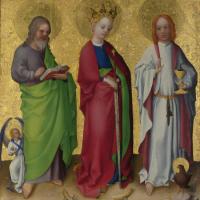Stefan Lochner
Drei Heilige
$540.00
Stefan Lochner
Stefan Lochner (1410-1451)
Stefan Lochner (the Dombild Master or Master Stefan; 1410 – late 1451) was a German painter working in the late "soft style" of the International Gothic. His paintings combine that era's tendency toward long flowing lines and brilliant colours with the realism, virtuoso surface textures and innovative iconography of the early Northern Renaissance. Based in Cologne, a commercial and artistic hub of northern Europe, Lochner was one of the most important German painters before Albrecht Dürer. Extant works include single-panel oil paintings, devotional polyptychs and illuminated manuscripts, which often feature fanciful and blue-winged angels. Today some thirty-seven individual panels are attributed to him with confidence.

Less is known of his life. Art historians associating the Dombild Master with the historical Stefan Lochner believe he was born in Meersburg in south-west Germany around 1410, and that he spent some of his apprenticeship in the Low Countries. Records further indicate that his career developed quickly but was cut short by an early death. We know that he was commissioned around 1442 by the Cologne council to provide decorations for the visit of Emperor Frederick III, a major occasion for the city. Records from the following years indicate growing wealth and the purchase of a number of properties around the city. Thereafter he seems to have over-extended his finances and fallen into debt. Plague hit Cologne in 1451 and there, apart from the records of creditors, mention of Stephan Lochner ends; it is presumed he died that year, aged around 40.
Lochner's identity and reputation were lost until a revival of 15th-century art during the early 19th-century romantic period. Despite extensive historical research, attribution remains difficult; for centuries a number of associated works were grouped and loosely attributed to the Dombild Master, a notnametaken from the Dombild Altarpiece (in English cathedral picture, also known as the Altarpiece of the City's Patron Saints) still in Cologne Cathedral. One of Dürer's diary entries became key, 400 years later, in the 20th-century establishment of Lochner's identity. Only two attributed works are dated, and none are signed. His influence on successive generations of northern artists was substantial. Apart from the many direct copies made in the later 15th century, echoes of his panels can be seen in works by Rogier van der Weydenand Hans Memling. Lochner's work was praised by Friedrich Schlegel and Goethe for its qualities, especially the "sweetness and grace" of his Madonnas.
The historical evidence suggests that Lochner's paintings were well known and widely copied during his lifetime, and remained so until the 16th century. Early examples in ink after his Virgin in Adoration are in the British Museum and École nationale supérieure des Beaux-Arts. The influence of Lochner's Last Judgement can be seen in Hans Memling's Gdansk altarpiece, where the gates of Heaven are similar, as is the rendering of the blessed. Albrecht Dürer knew of him before his stay in Cologne, and Van der Weyden saw his paintings during his travel to Italy. The latter's Altar of Saint John is similar to Lochner's Flaying of Bartholomew, especially in the executioner's pose, while his Saint Columba altarpiece includes two motifs from Lochner's Adoration of the Magi triptych; specifically, the king in the central panel with his back to the viewer, and the girl in the right hand wing holding a basket containing doves.
The Heisterbach Altarpiece, a dismantled double set of wings now broken apart and divided between Bamberg and Cologne, is heavily indebted to Lochner's style. The inner panels show sixteen scenes from the lives of Christ and the Virgin that bear multiple similarities to Lochner's work, including in format, compositional motifs, physiognomyand colourisation. The work was for a period attributed to Lochner but is now generally accepted as bearing his strong influence. In 1954 Alfred Stange described the Master of the Heisterbach Altarpiece as Lochner's "best-known and most important pupil and follower", although research in 2014 indicates that the two may have collaborated on the panels.
Research in 2014 by Iris Schaeffer into the underdrawings of the Dombild Altarpiece established two guiding hands, presumably Lochner and an exceptionally talented pupil, whom she concludes was in probability the principal artist behind the Heisterbach Altarpiece. A counter view is that Lochner's workshop was producing to a deadline, and he delegated as a matter of expediency.





